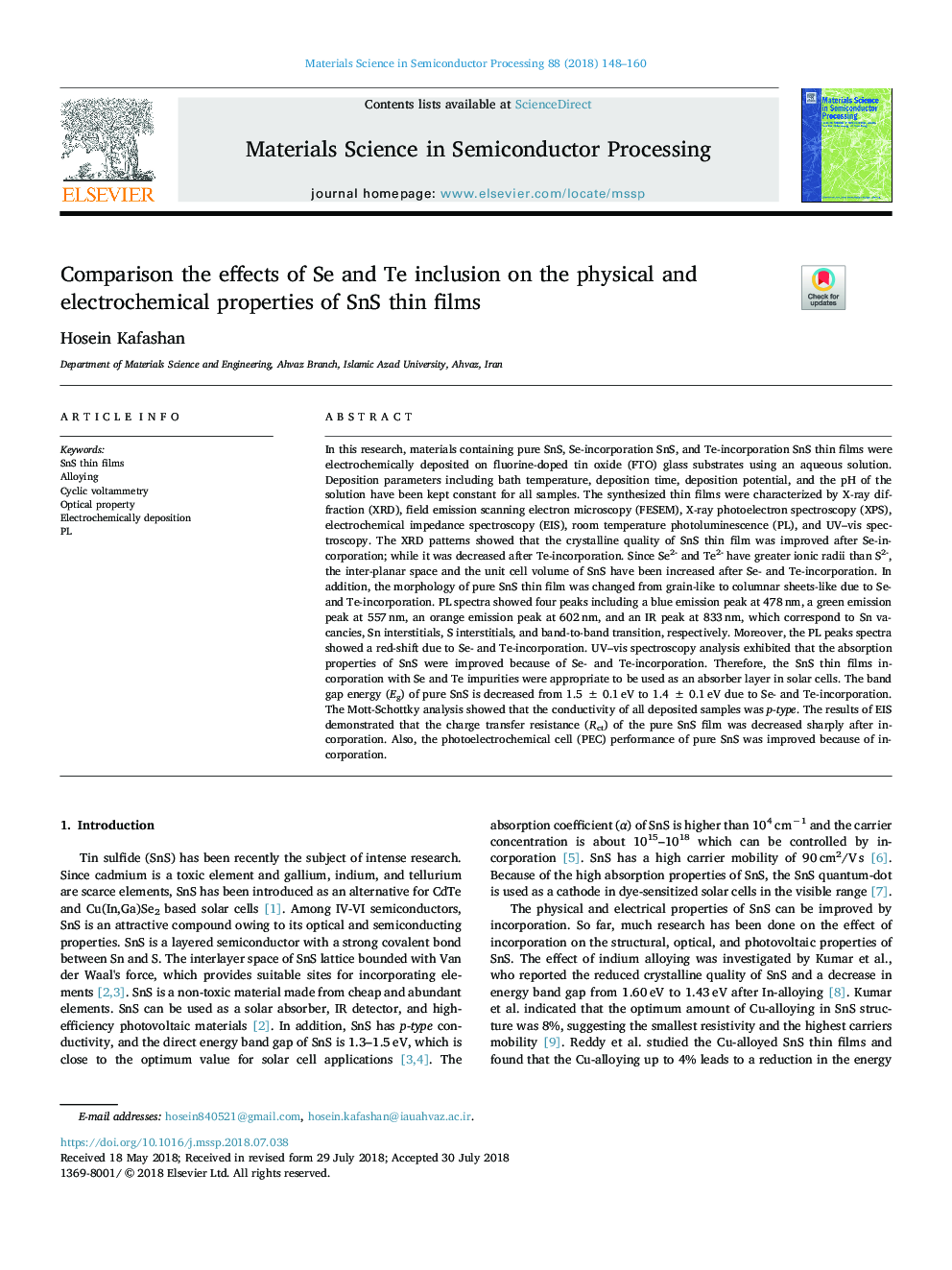| کد مقاله | کد نشریه | سال انتشار | مقاله انگلیسی | نسخه تمام متن |
|---|---|---|---|---|
| 7117344 | 1461359 | 2018 | 13 صفحه PDF | دانلود رایگان |
عنوان انگلیسی مقاله ISI
Comparison the effects of Se and Te inclusion on the physical and electrochemical properties of SnS thin films
دانلود مقاله + سفارش ترجمه
دانلود مقاله ISI انگلیسی
رایگان برای ایرانیان
کلمات کلیدی
موضوعات مرتبط
مهندسی و علوم پایه
سایر رشته های مهندسی
مهندسی برق و الکترونیک
پیش نمایش صفحه اول مقاله

چکیده انگلیسی
In this research, materials containing pure SnS, Se-incorporation SnS, and Te-incorporation SnS thin films were electrochemically deposited on fluorine-doped tin oxide (FTO) glass substrates using an aqueous solution. Deposition parameters including bath temperature, deposition time, deposition potential, and the pH of the solution have been kept constant for all samples. The synthesized thin films were characterized by X-ray diffraction (XRD), field emission scanning electron microscopy (FESEM), X-ray photoelectron spectroscopy (XPS), electrochemical impedance spectroscopy (EIS), room temperature photoluminescence (PL), and UV-vis spectroscopy. The XRD patterns showed that the crystalline quality of SnS thin film was improved after Se-incorporation; while it was decreased after Te-incorporation. Since Se2- and Te2- have greater ionic radii than S2-, the inter-planar space and the unit cell volume of SnS have been increased after Se- and Te-incorporation. In addition, the morphology of pure SnS thin film was changed from grain-like to columnar sheets-like due to Se- and Te-incorporation. PL spectra showed four peaks including a blue emission peak at 478â¯nm, a green emission peak at 557â¯nm, an orange emission peak at 602â¯nm, and an IR peak at 833â¯nm, which correspond to Sn vacancies, Sn interstitials, S interstitials, and band-to-band transition, respectively. Moreover, the PL peaks spectra showed a red-shift due to Se- and Te-incorporation. UV-vis spectroscopy analysis exhibited that the absorption properties of SnS were improved because of Se- and Te-incorporation. Therefore, the SnS thin films incorporation with Se and Te impurities were appropriate to be used as an absorber layer in solar cells. The band gap energy (Eg) of pure SnS is decreased from 1.5â¯Â±â¯0.1â¯eV to 1.4â¯Â±â¯0.1â¯eV due to Se- and Te-incorporation. The Mott-Schottky analysis showed that the conductivity of all deposited samples was p-type. The results of EIS demonstrated that the charge transfer resistance (Rct) of the pure SnS film was decreased sharply after incorporation. Also, the photoelectrochemical cell (PEC) performance of pure SnS was improved because of incorporation.
ناشر
Database: Elsevier - ScienceDirect (ساینس دایرکت)
Journal: Materials Science in Semiconductor Processing - Volume 88, December 2018, Pages 148-160
Journal: Materials Science in Semiconductor Processing - Volume 88, December 2018, Pages 148-160
نویسندگان
Hosein Kafashan,